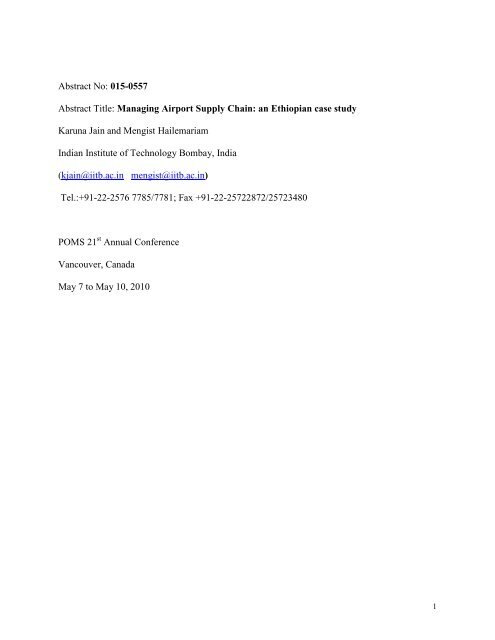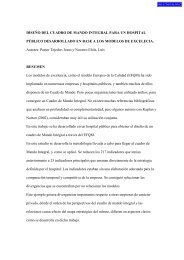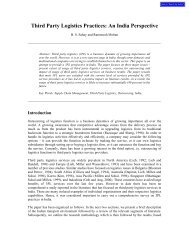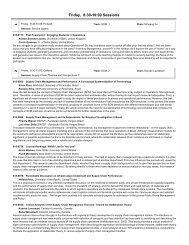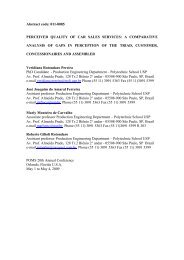Managing Airport Supply Chain - Pomsmeetings.org
Managing Airport Supply Chain - Pomsmeetings.org
Managing Airport Supply Chain - Pomsmeetings.org
You also want an ePaper? Increase the reach of your titles
YUMPU automatically turns print PDFs into web optimized ePapers that Google loves.
Abstract No: 015-0557<br />
Abstract Title: <strong>Managing</strong> <strong>Airport</strong> <strong>Supply</strong> <strong>Chain</strong>: an Ethiopian case study<br />
Karuna Jain and Mengist Hailemariam<br />
Indian Institute of Technology Bombay, India<br />
(kjain@iitb.ac.in mengist@iitb.ac.in)<br />
Tel.:+91-22-2576 7785/7781; Fax +91-22-25722872/25723480<br />
POMS 21 st Annual Conference<br />
Vancouver, Canada<br />
May 7 to May 10, 2010<br />
1
Abstract<br />
<strong>Managing</strong> <strong>Airport</strong> <strong>Supply</strong> <strong>Chain</strong>: an Ethiopian case study<br />
<strong>Airport</strong> is one of the most complex facilities which connect several business units to fulfil their<br />
roles within the air transport industry. <strong>Managing</strong> these entire business networks is one of the<br />
challenging areas. The characterization of the airport SC is a network of multiple <strong>org</strong>anizations<br />
and their relationship. It encompasses suppliers, airlines, airport operators, government agencies<br />
such as customs, security and immigration and other service providers. The purpose of this paper<br />
is to analyze the supply chain (SC) processes in Ethiopian airports and identify opportunities for<br />
enhancing airport performance.<br />
The study involved a combined methodology to data collection, taking Ethiopian <strong>Airport</strong>s<br />
Enterprise (EAE) and Addis Ababa Bole International <strong>Airport</strong> (AABIA) as a case. Data were<br />
collected through questionnaire from members of the entire airport SC and structured interview of<br />
key stakeholders. The case study provides practical insight for managing airport SC and how to<br />
enhance airport performance.<br />
Keywords: <strong>Airport</strong> SC, Efficiency and performance, Case study<br />
2
1. Introduction<br />
The airport is a service system which is a vital part of the air transportation of today's society. The<br />
airports in the 21 st<br />
century form an exciting long-term growth industry with excellent prospects.<br />
The industry is undergoing through quick change and becoming much more challenging for airport<br />
managers (de Neufville and Odoni, 2003). This is owing to live competition, technology and<br />
<strong>org</strong>anizational change, and ever growing public demand for better airport services.<br />
In air transport services, airport act as a provider of the on-ground infrastructure for flight<br />
operations. <strong>Airport</strong> facilitates the link between passengers arriving by different modes and their<br />
access to aircraft while airlines offer the transportation services per se (Albers et al, 2005).<br />
Ashford, et al., (1984) pointed out that airports constitute an <strong>org</strong>anization which either supply or<br />
administer the following facilities:<br />
• Servicing, maintenance, and engineering of aircraft;<br />
• Airline operations including aircrew, cabin attendants, ground crew, terminal and office staff;<br />
• Business necessary for economic stability of airport (concessions, leasing companies, etc.);<br />
• Aviation support facilities (air traffic control, meteorology, etc.); and<br />
• Government functions- agricultural inspections, customs, immigration and health.<br />
The characterization of the airport SC is a network of multiple <strong>org</strong>anizations and their<br />
relationship. It encompasses suppliers, airlines, airport operators, government agencies such as<br />
customs, security and immigration and other service providers. <strong>Managing</strong> these entire business<br />
networks is one of the challenging areas.<br />
<strong>Supply</strong> chain management (SCM) in the airport business involves overseeing relationships<br />
among all members in the chain, controlling inventory, demand forecasting and getting constant<br />
feedback on what is happening at every link with the aim of adding value to all members down the<br />
3
SC. SCM decisions have direct impact on airport’s operation and financial performance. In turn,<br />
this influences all members in the chain.<br />
Many researchers and practitioners have studied SC issues related to manufacturing and some<br />
service industry such as retail. Previous studies in the airport industry mainly focused on airport<br />
systems design, planning, safety, infrastructure and master planning, and related areas. However,<br />
little attention has been paid by researchers to study SC issues in the sector. The industry needs to<br />
be examined from an integrated delivery of customer services perspective that is, as a network of<br />
airport SCs. In view of that, the purpose of this paper is to understand the SC processes in airports<br />
in particular Addis Ababa Bole International <strong>Airport</strong> (AABIA) and identify opportunities for<br />
enhancing airport performance. An Ethiopian airport was selected based on the accessibility to<br />
information and willingness to share the information.<br />
This paper is structured as follows. A brief description of the case enterprise and its airport is<br />
given. Then, a literature review relevant to SC in the airport context is presented followed by the<br />
research methodology and analysis. Findings of the case are discussed next. Finally, conclusions<br />
are presented.<br />
2. The case:<br />
The Ethiopian <strong>Airport</strong>s Enterprise (EAE) was established as a public enterprise in January 2003<br />
due to increasing demand for airport services and remarkable changes in the aviation sector to<br />
meet international aviation standards by restructuring Ethiopian Civil Aviation Authority (ECAA).<br />
The establishment of the enterprise as an independent legal entity to run the airport service<br />
delivery is a new phenomenon in the aviation history of the nation. ECAA is restructured to<br />
perform the aviation regulatory services. The aviation security is <strong>org</strong>anized under the National<br />
Security and Intelligent Authority to carry out the security activities (Estifanos, 2002).<br />
4
At present, the EAE runs 14 airports (4 international and 10 domestic/regional) and airstrips<br />
across the country. AABIA located at the capital of Ethiopia is a public major airport and provides<br />
international and domestic service. It has having a modern pave runway capable of handling<br />
aircraft such as B747/MD11 with five taxi ways. AABIA generates more than 80% of the<br />
passenger movements and 90% of total revenue of the EAE (data source: Statistics team of EAE).<br />
The AABIA has served the nation as the main international gateway for more than 44 years. It<br />
has witnessed a growth of passenger and freight volumes over the last five years. In 2008, the<br />
passenger traffic at AABIA was more than 3 million and freight handled was 80515.28 Ton,<br />
implying a growth of 17% in passenger traffic and 36% caro handled over the previous year. [1]<br />
AABIA’s potential in serving as a hub for air traffic to most of African countries as well as a<br />
transfer point to Asia and Middle East, is one of the important drivers and opportunities for the<br />
current and future growth of air traffic in Ethiopia. Other drivers include, the country hosts many<br />
international <strong>org</strong>anizations such as the African Union, the African Economic Commission and<br />
international embassies and consulates and the potential for growth in domestic air transport and<br />
significant potential for tourism development.<br />
Currently, 11 international flight operators including the national airline-Ethiopian and other 10<br />
foreign airlines from Africa, Middle East, and Europe are operating at AABIA. Five Domestic<br />
Operators are also functioning in the airport. [2]<br />
The AABIA provides a wide range of service and facilities to passengers, airlines and other<br />
airport users. It is the first airport in Africa to operate bar coded boarding passes for all<br />
international flights. Several <strong>org</strong>anizations are also involved in the airport service provision with<br />
__________________<br />
[1] http://www.ethiopianairports.com<br />
[2] Flyer, EAE, prepared by Planning & Market Development Coordination Office, Unpublished<br />
Available at: http://www.ethiopianairports.com/index.aspx<br />
5
different ownership and regulatory structure. The national carrier, Ethiopian airlines provides<br />
handling services to passengers including ticket and baggage check in, the airport immigration<br />
provide passport and visa inspection services, the airport customs perform customs inspection and<br />
the airport security provide security inspections.<br />
The EAE presently has about 915 permanent employees of which 33.5% work at AABIA; the<br />
other 25% of the workers position at head office and others at regional airports. In general, fully<br />
equipped with state-of-the-art facilities, AABIA is one of the best airports in Africa. EAE was<br />
awarded a corporate achievement award for excellence in aviation industry at the 15th aviation and<br />
allied business leadership conference in 2009. The award was in recognition of EAE's<br />
contributions to the development of the aviation industry in Africa.<br />
3. The airport SC<br />
Realizing success in a competitive environment calls for managing activities involved directly or<br />
indirectly to fulfil customer requirements. Activities should be designed to reduce operational<br />
costs, to improve flow of supplies and to increase customer satisfaction. The processes of SCM<br />
integrate intra and inter-company activities through cooperative <strong>org</strong>anizational relationships and<br />
results effective business processes (Handfield and Nichols, 2002; Mentzer, 2001).<br />
Several initiatives are mandatory for the successful implementation of SCM practices/processes<br />
that offer companies a sustainable competitive advantage and success. Some of the factors which<br />
directly support or enable <strong>org</strong>anizations achieve their SC objectives found in literature include:<br />
creating corporate culture (Chin, et al., 2004; McIvor and McHugh, 2000); deploying technology<br />
to support SC decision making (Tummala, et al., 2006; Chin, et al.,2004; Davis, 2003); skill and<br />
responsibility to manage, operate and to make SC better; alignment of SC strategy with firms’<br />
business strategy; adaptability and agility of the system (Hau, 2004; Hugos, 2003; Kidd, 2001;<br />
[1]<br />
6
Christopher and Towill, 2001). Researchers have identified enablers to SC performance including<br />
long term relationship, communication and cooperation, cross-sectional teams and supplier’s<br />
relationship, risk and reward sharing, agreed vision and goals, information sharing (Chen and<br />
Paulraj, 2004), effective performance management and reward for best performance (Chin, et<br />
al.,2004), process integration and continuous process flow (Fish and Forrest, 2006; Donlon, 1996),<br />
quality and customer relations (Tan, et al., 1998) and elimination of excess stock levels (Alvardo<br />
and Kotzab, 2001).<br />
The SC success can be measured through end customers, operational and financial benefits.<br />
Customer benefits include improved product/service quality, timeliness, flexibility, and added<br />
value delivered to customers. Operational benefits are waste reduction, time compression, flexible<br />
responses, and unit cost reduction. The financial benefits are profit margins, cash flow, revenue<br />
growth, and return on assets.<br />
From SC point of view, the airports’ service provision represents the cumulative effect of<br />
multiple <strong>org</strong>anizations and their relationships to offer products and services to the end customers.<br />
In its daily business, airport involves several suppliers, airlines, operators, stakeholders,<br />
government agencies such as customs, security and immigration, passengers and other users. It is<br />
part of an interconnected network of its own suppliers and customers. This network is the context<br />
in which its SC is developed. SC structure for an airport with the key players and their business<br />
functions are illustrated in figure 1. The various players those who interact with the airport<br />
operator in an airport are shown in figure 2. It is obvious that several players play their role in order<br />
to deliver services and products to the end customer. Close cooperation and coordination among<br />
the players is required for effective service. For airports to function efficiently, equilibrium<br />
between the main players and all their associated <strong>org</strong>anizations must be achieved.<br />
7
<strong>Airport</strong><br />
Suppliers<br />
<strong>Airport</strong> support<br />
firms<br />
Fuel supply<br />
Sanitary service<br />
Maintenance<br />
Information, Service, Product, Knowledge & Finance<br />
Figure1: Conceptual SC structure with most important players and their business functions<br />
<strong>Airport</strong><br />
Authorities<br />
Freight<br />
forwarders<br />
<strong>Airport</strong><br />
Operator<br />
Concessionaires<br />
SC network<br />
Airline representation<br />
Passenger services<br />
Ground services<br />
Flight operations<br />
Government services<br />
SC business processes<br />
Security/Police<br />
<strong>Airport</strong> Operator<br />
Government<br />
Inspections<br />
Figure 2 Various players who interact with airport operator<br />
Immigration<br />
Customs<br />
Airlines/<br />
Air cargo<br />
Operator<br />
Transport passengers<br />
& freight/Mail<br />
Operate aircraft<br />
All cargo carriers<br />
Handling<br />
Agents<br />
Air traffic<br />
Control (ATC)<br />
Passengers<br />
/Freight<br />
8
So, a high degree of coordination for position of other parties’ is vital otherwise sub-optimal<br />
conditions exist leading to failure in service delivery. Thus, each and every entity of the airport SC<br />
is responsible towards creating a SC environment which is a source of competitive advantage.<br />
4. Methodology and Data collection<br />
This research is based on the case study methodology aimed at obtaining an in-depth knowledge of<br />
the SCM processes and practices in one of the Ethiopian airports. Survey was conducted during the<br />
period from March 15 to August 15, 2009 of 110 respondents from EAE, AABIA, airlines<br />
operating in the airport and other stakeholders.<br />
The study involved a combined methodological approach to data collection (Eisenhardt, 1989),<br />
namely; documentary and archival data from EAE, semi-structured interviews and self<br />
administered questionnaire. An on-site visit to the case study airport and reviewing secondary<br />
sources helped to collect data about physically taking place activities in the airport industry in their<br />
usual contexts and enabled to map the entire airport business SC. This also led to the development<br />
of interview with its protocol and questionnaire. Data collection was along the entire supplier,<br />
focal airport and airlines’ network. Different functional groups and employees in each business<br />
unit are participated for more comprehensive information. As a result, the principal unit of analysis<br />
constitutes the entire airport SC as opposed to one participant along the chain. Hence, it has<br />
increased the reliability of the case study and construct validity is assured (Yin, 2003).<br />
82 questionnaires were returned from the respondents with 78 completed/valid responses from a<br />
total of 110 questionnaires sent; implying an overall response rate of 78.37%. It was very<br />
satisfactory indicating validity of the result as opposed to 15-20% response rate assumed as normal<br />
(Gilgeous and Gilgeous, 2001).<br />
9
5. Survey findings and analysis<br />
The survey findings from the first section of the questionnaire describing background information<br />
about the respondents and their company and preliminary data about their airport SC structure are<br />
discussed in brief.<br />
The composition of the respondents representing major players in the airport industry is<br />
illustrated in figure 3. The sample characteristics indicated as others (8%) include respondents<br />
from audit and inspection, legal services, customs and so on.<br />
Figure 3: Composition of respondents’<br />
The respondents were requested to rank the first five airport business value drivers. The survey<br />
findings are shown in table 1. Respondents were also asked to identify some of the SC activities in<br />
AABIA. Customer service, purchasing, procurement, and sourcing are the first two primary SC<br />
activities mentioned by respondents as illustrated in figure 4.<br />
Table 1: Value drivers and key customers for airport<br />
Rank Value drivers Key customers<br />
st<br />
1 Passenger growth<br />
Airlines<br />
2 nd<br />
Aircraft movement Passengers<br />
3 rd<br />
Nonaeronautical services Concessionaires<br />
4 th<br />
Concession rates<br />
Governmenr<br />
Aeronautical services Tour operators<br />
5 th<br />
10
Figure 4: Importance of SC activities in airport business<br />
Figure 5 exhibits the list of tools, techniques and methods the airport has employed to improve<br />
its SC performance. As it is evident from the figure, about half of the respondents viewed BPR as<br />
one of the methods used in the airport to improve its performance followed by benchmarking<br />
(20%). The study found that, some of the respondents considered a combination of two/three of the<br />
given alternatives. BPR, technology and benchmarking were included in most of the<br />
combinations.<br />
Figure 5: Methods and tools used by the airport<br />
The second section, the main part of the questionnaire consists of the five themes of the SC<br />
processes/practices that were identified as key SC processes/practices from literature. The<br />
respondents were requested to show their level of agreement to statements given on a seven-point<br />
scale for each of these themes. Our observation and findings from the responses are as follows:<br />
11
Corporate culture and decision making in the airport SC<br />
Corporate culture and decision making is a major task of <strong>org</strong>anizations’ leadership to achieve SC<br />
and business strategy. People success is a function also of the corporate culture, how the company<br />
sees itself, defines itself and operates, both internally and externally. The culture can be a<br />
facilitator of processes or an inhibitor (Craig, 2003). The way management think, feel and act in<br />
managing SC operation in any <strong>org</strong>anization have direct impact in its SC capability. In this context,<br />
with the aim of describing this practice in the SC of AABIA, the study revealed that the corporate<br />
culture and decision making practice operated in the airport are not appropriate.<br />
The corporate culture and decision making practices in the SC of the airport seem to lack most of<br />
the components mentioned in literature. Lack of measurable quality service culture, unavailability<br />
of cross functional teams, unable to evaluate the existing SC system and corporate culture for the<br />
benefit of all members are the major ones.<br />
The airport must view SC as a strategic asset and should create alertness for all involved in the<br />
network and its value to the airport business. To tackle airport operational, technical and<br />
commercial confront of the current and future, EAE should have a staff development program. It<br />
also needs to consider continuous training in SCM processes. In general, the change in corporate<br />
culture is compulsory for EAE as it is a prerequisite for successful SCM. These fundamentals if<br />
put into practice, can lead to continuous step up and improved SC performance.<br />
Partnership and collaboration in the airport SC<br />
SCs by nature and definition require <strong>org</strong>anisations to work together in close relationships and<br />
collaboration with all involved throughout the chain purposefully to add value to the end customer<br />
(Handfield and Nichols, 2002). The literature suggests that high level of integration is associated<br />
12
with high level of performance (Frohlich and Westbrook, 2001). Partnership and collaboration<br />
should be both internal (employees, departments, teams, sections and functional units) and<br />
external to the <strong>org</strong>anization (Bowersox, et al., 2000). In the airport industry, the latter includes<br />
suppliers, airlines, service providers and customs, security, immigration and other players. A long<br />
term partnership and collaboration across <strong>org</strong>anizational boundaries enhances competitiveness to<br />
all involved in the chain. It also extends commitment to achieve SC excellence with airport<br />
partners. Unable to create such a working environment results likely ineffective SC (Fish and<br />
Forrest, 2006; Davis, 2003; Tummala, et al, 2006).<br />
The status of partnership and collaboration in the SC of AABIA is not up to the mark but is being<br />
developed (advancement in SC partner integration process is slow). The services delivered at<br />
airports involve employees, airline operators, immigration, customs, airport security, airport<br />
support service providers and other players. It calls for effective coordination and partnership<br />
among these players.<br />
EAE and AABIA should initiate to collaborate better with both internal and external partners and<br />
business units. Emphasis should be placed in three dimensions of the airport SCM coordination<br />
and integration: within each function of the EAE (intra-functional), among the functional areas<br />
(inter-functional) like marketing and operations, and to coordinate all the multiple enterprises<br />
(inter-<strong>org</strong>anization) from supplier to airlines. This effort should start from internal and proceed to<br />
external by improving efficiencies first within functions, then across functions, and between and<br />
across multiple firms (Carter et al., 2000). All members should contribute their share for effective<br />
service delivery and enhances competitiveness to all parties involved in the chain. The EAE and<br />
its airport need to take step forward to build collaboration and partnership on priority basis as it<br />
takes longer to build partnership.<br />
13
<strong>Airport</strong> SC information management system<br />
Information sharing is identified as one of the key drivers for improving airport SC performance and<br />
enhancing competitive advantage (Zhang and Li, 2006). Effective information flow which is visible,<br />
frequent, and accurate in the SC enable firms to better create, process and deliver product and<br />
services to their ultimate customers. To identify the SC information management system<br />
processes/practices in the airport, respondents were requested to indicate their level of agreement<br />
to the six statements that capture the effectiveness of information management system. It is<br />
surprising to note that respondents do not consider these important as shown in figure 6.<br />
Figure 6: <strong>Airport</strong> SC information management<br />
This clearly suggests that EAE and AABIA need to synchronize new ways of thinking and<br />
strategy to reduce cost and enhance partners’ satisfaction. The AABIA should improve its<br />
management process, working system and capacity building concern based on SCM principles. It<br />
should build adequate SC infrastructure and technology plan with partners. It also needs to deploy<br />
technology and techniques to deliver quality information on time to partners along with regular<br />
channel of communication and feedback. This is critical for both EAE and AABIA to attain SC<br />
excellence and drive outcomes.<br />
14
Performance measurement in airport SC<br />
For airport industry it is a necessity to know how the network of businesses and relationships<br />
would perform at each stage including airlines, users and other stakeholders. Hence, periodic<br />
monitoring and improvement of the activities and outcomes leading to value creation is essential.<br />
This is the primary task of performance measurement system (Hailemariam and Jain, 2009).<br />
Accurate performance measurement is helpful in knowing how well airports are meeting<br />
customers’ requirements as well as how they are handling their SC operation and business.<br />
Holmberg, (2000) and Lai, et al., (2002) argue that a number of researchers and practitioners have<br />
highlighted the need for vital performance measurement and measures in the SC which is aligned<br />
to desired outcomes.<br />
The study found that the SC performance measurement system in the airport is not considering<br />
the factors that are critical to measure performance. In effect, there is no a well <strong>org</strong>anized<br />
performance measurement system.<br />
To create value and remain competitive in the changing business environment AABIA will<br />
require effective performance measurement system based on the key performance indicators used<br />
in airport industry. It is crucial that the EAE also develops well designed, forward looking<br />
performance measurement system having relevant metrics aligned with goals that enable<br />
appropriate decision making (Hailemariam and Jain, 2009). The system must enable the<br />
management to improve procedures and processes continuously, and evaluate the success and<br />
failure of SC operations of the airport.<br />
Value adding and optimizing in the airport SC activities<br />
During examining airport SC processes, it is meaningful to determine the values that are being<br />
added by the individual activities/processes. It is also vital to identify activities and processes that<br />
15
add value. Non value added activities in the SC exist in airport SC operations such as check in,<br />
flight operations, terminal operations (safety, security and emergency services) and ground<br />
services like passengers handling, ticketing, luggage, in-flight and cargo-mail handling and other<br />
services .<br />
It is interesting to note that the airports has initiated efforts towards reducing non value add<br />
activities in the airport SC (figure 7).<br />
Figure 7: Value adding and optimizing airport SC activities<br />
In a competitive business environment, to become a world-class service <strong>org</strong>anization it is<br />
necessary to create value to the customer and achieve operational excellence to enhance financial<br />
performance. This can be ensured by minimizing non value added (waste) activities throughout the<br />
system while accomplishing the mission. In general, anything that classifies as waste within<br />
company will also be waste from SC point of view (Phelps, et al., 2003). Hence, EAE and AABIA<br />
must coordinate and integrate internal functions or value chain activities.<br />
The EAE must focus on core responsibilities and improve them by outsourcing non core activities<br />
and ensure that it does value chain activities better than its competitors. It is useful to<br />
conceptualize a SC process improvement scenario for EAE based on the above findings and<br />
discussions. Hence, a SC process improvement framework consisting of three core dimensions is<br />
proposed and illustrated in figure 8. The first dimension represents the working culture and its<br />
16
impact on SC decisions. It is this dimension that plays crucial role in the improvement initiatives<br />
of the airports’ performance. The second dimension is the collaboration among the partners of the<br />
airport SC. The third dimension is the core capability of partners’. For each of the dimensions we<br />
have listed some of the considerations to improve the performance of the airport SC and airport.<br />
Few considerations Concern<br />
6. Conclusions<br />
<strong>Airport</strong> Authority/<br />
<strong>Airport</strong><br />
• Adoption of best<br />
practices<br />
• Commitment &<br />
passion for excellence<br />
• Extend facilities &<br />
technology<br />
• Continue improvement<br />
Figure 8: The proposed SC process improvement framework<br />
Due to continuous increase in the number of passenger, aircraft movement and the need for ever<br />
growing public demand for better services, airport industries need to continually strive to achieve<br />
operational success better than anyone else. The only way to meet current and future airport<br />
challenges is to build capability and competency in SCM. In this case study, we have studied the<br />
SC processes/practices in an Ethiopian airport industry. We have found that some SC processes are<br />
critical for airport operations. It is remarkable to note that our findings match with the findings of<br />
the study conducted by IATA team (2008). The findings of IATA study permit the EAE and<br />
AABIA to recognize the importance of SC as a source of competitive advantage to their<br />
operational and financial efficiency. Our study has also identified five areas of SCM<br />
processes/practices relevant to the airport industry.<br />
Across Company<br />
Collaboration<br />
• Intra & inter-industry<br />
scope<br />
• Close relationship<br />
• Monitoring partners’<br />
performance<br />
• System integration<br />
Core Capability<br />
• Activities & processes<br />
development<br />
• Learning &<br />
development<br />
• Physical & financial<br />
resources<br />
17
References<br />
Albers, S., Koch, B. & Ruff, C. 2005. Strategic alliances between airlines & airports-theoretical<br />
assessment & practice evidence. Journal of Air Transport Management, 11(2), 49-58.<br />
Alvarado, UY. & Kotzab, H. 2001. <strong>Supply</strong> chain management: the integration of logistics in<br />
marketing, Industrial Marketing Management, 30(2), 183–198.<br />
Ashford, N., Martin, H.P. & Moore, C.A. 1984. <strong>Airport</strong> Operations. John Wiley & Sons, Inc., NY.<br />
Bowersox, DJ., Closs, DJ., Stank, TP. & Keller, SB. 2000. How <strong>Supply</strong> <strong>Chain</strong> Competency Leads<br />
to Business Success. <strong>Supply</strong> <strong>Chain</strong> Management Review, 4(4), 70-76.<br />
Carter, PL., Carter, JR., Monzcka, RM., Slaight, TH. & Swan, AJ. 2000. The Future of Purchasing<br />
& <strong>Supply</strong>: a ten-year forecast. Journal of <strong>Supply</strong> <strong>Chain</strong> Management, 36(1), 4-26.<br />
Chen, IJ. & Paulraj, A. 2004. Towards a theory of supply chain management: the constructs &<br />
measurements, Journal of Operations Management, 22(2), 119-150.<br />
Chin, K.S, Tummala, R. V.M, Leung, J. P.F & Tang, X. 2004. A study on supply chain<br />
management practices: The Hong Kong manufacturing perspective. International Journal of<br />
Physical Distribution & Logistics, 34(6), 505–524.<br />
Christopher, M., Towill, D. 2001. An integrated model for the design of agile supply chains.<br />
International Journal of Physical Distribution & Logistics, 31(4), 234–246.<br />
Craig, T. 2003. 3 Issues to <strong>Supply</strong> <strong>Chain</strong> Management Success-Process, people, technology.<br />
World Wide Shipping (July/August 2003) Available at www.ltdmgmt.com/072503.asp<br />
Davis, M., Aquilano, N., Chase, R. 2003. Fundamentals of Operations Management. McGraw-Hill,<br />
Boston.<br />
de Neufville, R., Odoni, A. 2003. <strong>Airport</strong> Systems planning, design, & management. McGrawHill,<br />
NY.<br />
18
de Waart, D., Kemper, S. 2004. Five Steps to Service <strong>Supply</strong> <strong>Chain</strong> Excellence, available<br />
at: http://www.scmr.com/article/CA386249.html (1/1/2004)<br />
Donlon, JP. 1996. Maximizing value in the supply chain, Chief Executive, 117, 54–63.<br />
Eisenhardt, K. 1989. Building theories from case study research. Academy of Management<br />
Review, 14(4), 532-550.<br />
Estifanos, Eyob. 2002. Public Policy & Private Investment in the Air Transport sector,<br />
Unpublished.<br />
Fish, Lynn A., Forrest, Wayne C. 2006. The 7 Success Factors of RFID. <strong>Supply</strong> <strong>Chain</strong><br />
Management Review, 9/1/2006.<br />
Frohlich, M., Westbrook, R. 2001. Arcs of integration: an international study of supply chain<br />
strategies. Journal of Operations management, 19(2), 185-200.<br />
Gilgeous, V., Gilgeous, M. 2001. A survey to assess the use of a framework for manufacturing<br />
excellence., Integrated Manufacturing Systems, 12(1), 48–58.<br />
Hailemariam, M., Jain, Karuna. 2009. A Framework for measuring supply chain performance in<br />
aviation industry. In Jain and Patil (eds.), 2 nd Indian Subcontinent Decision Sciences Institute<br />
International Conference Proceedings 2009 on Decision Sciences in Global Enterprise<br />
Management, IIT Bombay, 3-5 January 2009 Mumbai, 34-44.<br />
Handfield, Robert B. & Nichols, Ernest L. 2002. <strong>Supply</strong> chain redesign: Transforming supply<br />
chains to integrated value systems. Pearsons Education. Inc, NJ.<br />
Hau L, Lee. 2004. The Triple-A <strong>Supply</strong> <strong>Chain</strong>. Harvard Business Review, 1 October.<br />
Holmberg, S. 2000. A systems perspective on supply chain measurements. Journal of Physical<br />
Distribution & Logistics Management, 30(10), 847-868.<br />
Hugos, Michael H. 2003. Essentials of <strong>Supply</strong> <strong>Chain</strong> Management. John Wiley & Sons, Inc. NY.<br />
19
IATA team. 2008. Interim Strategic Analysis Report of the external and internal environment of<br />
the EAE, November, 2008, unpublished.<br />
Kidd, P.T. 2001. E-business Strategy: Case Studies, Benefits and Implementation, E-business<br />
Series, Cheshire Henbury Publications, UK.<br />
Lester, M. 2000. An interview with Edith Kelly-Green: one on one. Journal of <strong>Supply</strong> <strong>Chain</strong><br />
Management, 36(2), 2-3.<br />
McIvor, R., McHugh, M. 2000. Partnership sourcing: an <strong>org</strong>anization change management<br />
perspective. Journal of <strong>Supply</strong> <strong>Chain</strong> Management, 36(3), 12-20.<br />
Mentzer, John T. 2001. <strong>Supply</strong> <strong>Chain</strong> Management. Sage Publications, Inc., California.<br />
Phelps, T., Hoenes, T., & Smith, M. 2003. Developing Lean <strong>Supply</strong> <strong>Chain</strong> a guide book. Altarum,<br />
Boeing & Messier-Dowty.<br />
Tan, KC, Kannan, VR & Handfield, RB. 1998. <strong>Supply</strong> chain management: supplier performance<br />
and firm performance, Journal of Purchasing and Materials Management, 34(3), 2–9.<br />
Tummala, V.M. Rao, Philips, Cheryl L.M. & Johnson, Melanie. 2006. Assessing supply chain<br />
management success factors: a case study, <strong>Supply</strong> <strong>Chain</strong> Management International Journal,<br />
11(2), 179-192.<br />
Yin, Robert K. 2003. Case Study Research: design & methods. Sage publications, Inc., NY.<br />
Zhang, C., Li, S. 2006. Secure information sharing in internet-based supply chain management<br />
systems. Journal of Computer Information Systems, 46(4), 18-24.<br />
20


